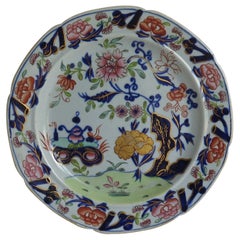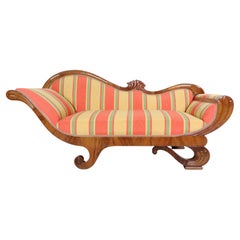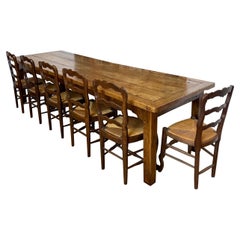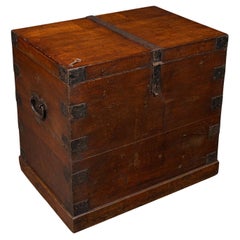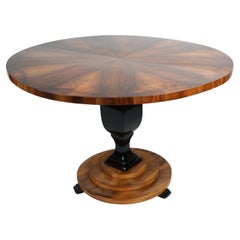Europe
to
1,910
10,501
8,070
344,851
250,509
157,889
141,015
103,859
77,206
50,738
50,114
44,006
35,274
28,316
27,354
22,601
20,014
15,984
15,570
14,747
14,180
11,697
10,739
10,462
7,580
5,842
5,748
4,977
4,410
4,314
3,594
2,817
2,609
2,118
2,112
1,940
1,552
1,469
1,277
1,188
1,135
1,005
954
932
857
715
683
523
500
392
302
281
228
221
197
195
168
165
154
115
109
99
60
45
39
97
42
39
27
24
Period: Early 19th Century
Period: 1610s
Georgian Masons Ironstone Desert Plate Vase Flowers & Rock Ptn, circa 1815
By Mason's Ironstone
Located in Lincoln, Lincolnshire
This is a fine Ironstone pottery Desert Plate made by the Mason's factory at Lane Delph, Staffordshire, England and beautifully decorated in the Small Vase, flower & Rock Pattern, fully stamped and dating to the earliest period of Mason's Ironstone production, circa 1815.
This design is one of Mason's very decorative chinoiserie patterns called the Small Vase, Flowers and Rock pattern, with a bamboo stem border and rich hand gilding. This Imari inspired pattern is illustrated on Page 110 of a Guide to Mason's Patent Ironstone Patterns, circa 1813-1848, produced by The Mason's Collectors Club.
This plate has probably the earliest impressed mark stating " Patent Ironstone China" in a circle, dating it to the early 19th century, Georgian period, circa 1815.
Overall a very early Masons Plate...
Category
Early 19th Century English Chinoiserie Antique Europe
Materials
Ironstone
19th Century Fine Biedermeier Walnut Recamiere. Vienna, c. 1825.
Located in Vienna, AT
We are delighted to present this truly unique and exceptional Viennese Biedermeier recamiere / daybed, crafted around 1825. This magnificent piece not only embodies the timeless eleg...
Category
Early 19th Century Austrian Biedermeier Antique Europe
Materials
Upholstery, Walnut
Large elm farmhouse table , French circa 3.18
Located in Budleigh Salterton, GB
Stunning example of an early 19th century elm farmhouse table
French circa 1820’s from the Brittany region of France
Constructed from solid elm , this table has bags of character wil...
Category
1820s French Country Antique Europe
Materials
Elm
A Large Antique English Regency Gold Gilt wood Overmantel Mirror
Located in London, GB
A large gilt wood English Regency period over mantle mirror. The frame with reeded columns decorated with large carved acanthus to top and bottom. retaining its original silvered mir...
Category
Early 19th Century English Regency Antique Europe
Materials
Giltwood
Antique Silver Chest, English, Oak, Iron Bound, Lined Storage Trunk, Georgian
Located in Hele, Devon, GB
This is an antique silver chest. An English, oak and bound iron storage trunk, dating to the Georgian period, circa 1800.
Superb living room or bedroom storage with fine Georgian ap...
Category
Early 19th Century British Georgian Antique Europe
Materials
Iron
19th Century Fine Biedermeier Walnut Table. Vienna, c. 1825.
Located in Vienna, AT
Hello,
This elegant and very rare, large Biedermeier walnut pedestal table is the best example of top-quality Viennese piece from circa 1820-25.
Viennese Biedermeier is distinguishe...
Category
Early 19th Century Austrian Biedermeier Antique Europe
Materials
Walnut
19th Century Empire / Biedermeier Walnut Secretaire
Located in Darmstadt, DE
A beautiful small secretary made of walnut veneer and solid walnut from the Biedermeier / Empire period at the beginning of the 19th century. The secretary is covered on the outside ...
Category
Early 19th Century German Biedermeier Antique Europe
Materials
Brass
2nd Cavalry Regiment (the Queen's Hussars) of the King's German Legion, 1828
Located in Langweer, NL
This hand-colored lithograph from the 19th century depicts an officer from the King's German Legion, specifically the "2nd Cavalry Regiment," also known ...
Category
1820s Antique Europe
Materials
Paper
19th Century French Louis XVI Limestone Fireplace Mantel
Located in Haarlem, Noord-Holland
Add a romantic and refined touch to your space with this exquisite Louis XVI period fireplace mantel in hand-carved limestone, originating from 19th century France. Offered by Scherm...
Category
Early 19th Century French Louis XVI Antique Europe
Materials
Stone, Limestone
Rare Antique Hand-Colored Butterfly Engravings by Edward Donovan (1820s)
Located in Langweer, NL
Title: Rare Antique Hand-Colored Butterfly Engravings by Edward Donovan (1820s) – Set of Four Exquisite Natural History Prints
This striking set of four antique butterfly prints rep...
Category
1820s Antique Europe
Materials
Paper
19th Century Fine Biedermeier Ebonized Sofa. Vienna, c. 1825.
Located in Vienna, AT
Hello,
This exceptional, ebonized Biedermeier sofa was made in Vienna circa 1820-25.
Viennese Biedermeier is distinguished by their sophisticated proportions, rare and refined desig...
Category
Early 19th Century Austrian Biedermeier Antique Europe
Materials
Pearlware, Upholstery
Pair of Empire mahogany armchairs - swan shaped armrest - attributed to Bellange
By Lelièvre Paris, Pierre-Antoine Bellangé
Located in GRENOBLE, FR
A fine pair of Empire mahogany armchairs in the style of French cabinet maker Pierre Antoine Bellangé (Bellangé was an official supplier to Imp...
Category
Early 19th Century French Empire Antique Europe
Materials
Silk, Mahogany
19th Century Swedish Antique Gustavian Cabinet with Original Paint
Located in Boden, SE
19th century Swedish antique Gustavian corner cabinet from Umeå Västerbotten, Northern Sweden.
Beautifully reeded doors.
Scraped by gentle hand to its well preserved original color...
Category
Early 19th Century Swedish Gustavian Antique Europe
Materials
Pine
19th Century Swedish Gustavian Style Secretary / Writing Desk - Painted
Located in Kvidinge, SE
Swedish Gustavian Secretary / Writing Desk from early 19th century
A rectangular top sitting above a slant front desk opening to reveal a gray painted interior and multiple smal draw...
Category
Early 19th Century Swedish Gustavian Antique Europe
Materials
Brass
Antique quality mahogany Dutch marquetry inlaid dressing table mirror
Located in Ipswich, GB
Antique quality mahogany Dutch marquetry inlaid dressing table mirror, quality antique Dutch marquetry inlaid tilting mirror above a marquetry inlaid base with one drawer working loc...
Category
Early 19th Century Dutch Colonial Antique Europe
Materials
Glass, Mahogany
Majestic Owls and Raptors: Exquisite Hand-Colored Engraving from Bertuch, 1805
Located in Langweer, NL
Owls and Raptors: Hand-Colored 19th-Century Engraving from Bertuch’s *Bilderbuch für Kinder*"
This striking hand-colored copperplate engraving features an array of owls and raptor...
Category
Early 1800s Antique Europe
Materials
Paper
Early 19th Century French School Vanitas Still Life Oil Painting on Canvas
Located in London, GB
Antique Vanitas Oil Painting, Antique Memento Mori Oil Painting, Antique Skull Oil Painting, Gothic Antique Painting, 19th Century Vanitas Still Life Oil Painting.
Early 19th Century French Vanitas Oil Painting on Canvas.
The Old Master Vanitas Still Life Painting depicts a skull, book and rosary.
Oil on canvas, lined. Unsigned.
In gold gilt period frame.
Very well painted, attractive & highly decorative Vanitas skull...
Category
Early 19th Century French Gothic Antique Europe
Materials
Canvas, Wood, Giltwood, Paint
Outstanding Quality Antique Dutch Marquetry Mahogany Inlaid Wall Mirror
Located in Suffolk, GB
Outstanding quality antique George III Dutch marquetry inlaid mahogany wall mirror with fantastic floral marquetry decoration and ornate brass decoration and having the original bevelled edge mirror plate.
A superior example, beautifully crafted and designed...
Category
Early 19th Century Dutch George III Antique Europe
Materials
Other
Gillows Imperial Patent Mahogany Dining Table
By Gillows of Lancaster & London
Located in Folkestone, GB
A superior quality extending mahogany dining table firmly attributed to Gillows and conforming precisely to a design in the Lancashire pattern books dated 1804. The reeded-edge top consisting of two hinged ends attached to short beds which join together to form a Pembroke-type table when all of the leaves are removed. The original and complete set of two narrow and two wider leaves are interchangeable and sit on the telescoping bed which is raised on elegant turned and reeded legs with brass castors. The four legs at each corner are fixed and the two central legs screw in when the table is extended.
Ref: Gillows of Lancaster and London, 1730-1840, by Susan Stuart, p. 242, pl.241: In identically designed table made for Broughton Hall...
Category
Early 19th Century English Regency Antique Europe
Materials
Mahogany
A Monumental Renaissance Revival Clock Garniture, Attributed to Feuchère
Located in Brighton, West Sussex
A Large and Important Louis Philippe Period Gilt-Bronze Three-Piece Clock Garniture.
Attributed to the Feuchère family. The clock movement by Hémon.
In the Renaissance revival style. Comprising a clock and a pair of nine-light candelabra. The clock case of architectural out-shape with cherubic term figures supporting a rectangular pediment centred by an urn. The sides of the clock tower cast in relief with strapwork and foliage. The dial inset with enamel Roman numeral chapters. The twin-barrel clock movement with tic-tac escapement, silk suspension and countwheel strike to bell. Pendulum and winding key.
The candelabra as twin-handled vases supporting tiered branches with candle nozzles. Modelled en suite with naturalistic scrolls and foliage. Surmounted by finials modelled as an eagle toying with a serpent. The scrolled handles flanked by cherubic figures and serpents. The bodies fronted by bacchic masks and supported on socles bearing angels.
France, Circa 1835.
The clock movement signed ‘HEMON A PARIS’. The clockmaker Claude Hémon was established at rue de St. Martin circa 1810-1820.
Dimensions, the clock:
Height : 106 cm 42 inches
Width : 58 cm 23 inches
Depth : 38 cm 15 inches
Weight : 72 kg
Dimensions, the candelabra:
Height : 104 cm 41 inches
Width : 36 cm 14 inches
Depth : 36 cm 14 inches
Weight : 28 kg (each)
This magnificent clock garniture of palatial size is designed in the Renaissance revival style and dates to the Louis Philippe period. Executed in sculptural gilt-bronze with leaves, scrolls, masks and exotic birds, the naturalistic ornament represents an elaborate system of allegories and mythological iconography which recall the influence of Italian Mannerist art in France.
The distinctive design reflects a new style which replaced the neoclassism of the French Empire period. With the fall of Napoleon Bonaparte, artists and designers sought a new decorative vocabulary with which to aggrandise the Bourbon restoration. With the French revolution and Louis XVI’s execution still within living memory, it seemed too soon for a revival of the style of the Grand Siècle. Instead they looked further back to the time of François I, whose patronage of Italian artists had brought the Renaissance to France. The idea of a renaissance revival appealed to the new Bourbon monarchs and their patronage ignited great creativity in the arts.
The reigns of Louis XVIII and Charles X, who were brothers of the late King, Louis XVI, and later of Louis Philippe I, nicknamed the Citizen King, coincided with the enlightenment and the dawn of the industrial age. Great technical progress was made in metallurgy and casting which raised the art of bronze making to new heights in the hands of great masters such as Pierre-Philippe Thomire (1751-1843) and Pierre- Jean-François Denière (1774-1866).
The renaissance provided a rich and varied source book in architecture, furniture and other decorative arts for designers such as Claude Aimé Chenavard (1798-1838) whose Album de l’ornemaniste (1835) became a reference work. Léon Feuchère (1804-1857) also produced drawings of interiors, silver, bronzes and furniture and was a scion of the prominent family of bronze castors established by his grandfather Pierre-François Feuchère (1737-1823) who had worked as a gilder for the bronze caster Pierre Gouthière before setting up a bronze foundry that would become one of the largest in Paris under the management of his son Lucien-François (d. 1841) and grand-son Armand (1797-1866). A number of drawings by Léon Feuchère have recently been discovered by the Rijksmuseum and probably belonged to the collection of Louis-Philippe-Albert, duc d’Orléans, comte de Paris (1838-1894). Louis-Philippe-Albert was the grandson of the French king, Louis-Philippe I (1773-1850), who granted him the title of comte de Paris, and the son of Ferdinand-Philippe, duc d’Orléans (1810-1842). Ferdinand-Philippe was an important collector and sponsored many young artists to create metalwork objets d’art, notably a celebrated surtout de table made by Claude-Aimé Chenavard and Jean-Jacques Feuchère (1807-1852), a cousin of Armand and Léon. Principally remembered as a sculptor, Jean-Jacques Feuchère trained in the family foundry and designed small objects, cigar boxes...
Category
Early 19th Century French Renaissance Revival Antique Europe
Materials
Bronze
Biedermeier Secretaire with Hidden Compartement, Walnut, Austria circa 1820
Located in Greven, DE
Secretary with black ink painting
Austria
Walnut
Biedermeier circa 1820
Dimensions: H x W x D: 155 x 85 x 46 cm
Description:
Exceptionally narrow writing desk with a highly intere...
Category
Early 19th Century Austrian Biedermeier Antique Europe
Materials
Walnut
19th Century Rare antique Northern Swedish pine Secretary clock desk country
Located in Boden, SE
19th Century Swedish Antique clock cabinet from Umeå Västerbotten ,Northern Sweden. . A good example of old ingenuity and compact living this pi...
Category
Early 1800s Swedish Gustavian Antique Europe
Materials
Pine
Antique French Aubusson Tapestry Living Room Set Louis XV
Located in Buxton, GB
We are delighted to offer for sale, this exquisite French Aubusson salon set is a stunning piece of antique furniture that will add elegance and ch...
Category
Early 19th Century French Louis XV Antique Europe
Materials
Tapestry, Giltwood
Antique Rare Georgian Sterling Silver Teapot by Paul Storr 1812 19th Century
By Paul Storr
Located in London, GB
This is an exceptional and very rare antique English George III sterling silver teapot by the world famous silversmith, Paul Storr, 1810 in date.
This splendid teapot is of a deligh...
Category
1810s English George III Antique Europe
Materials
Silver
Antique Victorian French Ornate Ormolu And Alabaster Mantle Clock
Located in Ipswich, GB
Antique Victorian French ornate ormolu and alabaster mantle clock having a quality pair of ormolu figures holding a birds nest over a circular porcelain dial with original hands, 8 d...
Category
Early 19th Century Victorian Antique Europe
Materials
Alabaster, Ormolu
Charlotte Shore Daughter Of The Governor General Of India Painted In India
By Arthur William Devis
Located in Sutton Poyntz, Dorset
Arthur William Devis.
English ( b.1762 - d.1822 ).
Portrait Of Charlotte Shore, Daughter Of The Governor General Of India, The 1st Lord Teignmouth.
Oil On Canvas.
Oval Image size 26.2 inches x 20.5 inches ( 66.5cm x 62cm ).
Frame size 34.6 inches x 28.7 inches ( 88cm x 73cm ).
Available for sale; this original oil painting is by Arthur William Devis and dates from around 1792 to 1795.
This painting was created when the sitter and the artist were both in India, the sitter's father being the Governor General of India from 1793 to 1798.
The painting is presented and supplied in a 19th century decorative frame. The painted surfaces and the frame have benefitted from some restoration, cleaning and conservation, which was performed on our instruction, supervision and approval. The canvas is lined.
This antique painting is in very good condition, commensurate with its age. It wants for nothing and is supplied ready to hang and display.
Provenance: By descent in the family of the sitter. Exhibited: Preston, Harris Museum and Art Gallery, 2000, Arthur William Devis, no.52.
Charlotte was the eldest child of the first Baron Teignmouth, a title that was created in 1798 for Sir John Shore. The title became extinct in 1981 on the death of the seventh Baron. This portrait was almost certainly painted by Devis in India at a time when the sitter’s father was Governor General. As such, this is a historically significant piece.
John Shore was an anti-slavery campaigner, born in London but brought up in Romford. In 1769 he went to work in Bengal where he was one of the first to learn a number of local languages. In 1785 he returned to England and on 14 February 1786 he married Charlotte, the only daughter of James Cornish, a medical practitioner at Teignmouth. The couple’s first child, Charlotte, the subject of this painting, was born the following year, on January 26, 1787. The family quickly returned to India, where John Shore served as Governor from 1793 to 1798. John and his wife had three sons and six daughters over the following fifteen years.
Sir John Shore left Calcutta for the final time in March 1798, sailing back to England with his wife and young family. The family settled in Clapham and Sir John became the first president of the British and Foreign Bible Society. He was involved with the Clapham Sect and their anti-slavery campaign.
This adorable original oil on canvas depicts Charlotte, the eldest child and first daughter of the first Lord Teignmouth, aged around five to seven years old. (On the basis that the family returned to England in 1798 when Charlotte would have been 11 years old, this painting was almost certainly created in India, during the time when her father was the Governor General of India. We also know that the artist was painting portraits in India the decade up to 1795, when he returned to England.)
Charlotte is an attractive child, with thick dark brown curly hair framing her beautiful angelic features. She has fair skin, rosy cheeks and rosebud lips. Her dark eyes are wide and engaging. She has the sweetest expression on her face and we feel that she is kind and good natured. She is wearing a simple white gown, typical of the day, with a low neckline and three- quarter length sleeves and a pale blue sash around her waist.
Arthur William Devis was one of the major English artists of the early nineteenth century, noted particularly for his portraits. His life was dynamic and engaging and he produced some of the definitive images of his generation.
Devis was born in London on 10 August 1763, the nineteenth child of the artist Arthur Devis and his wife Elizabeth Faulkner. There were several artists in the family and Devis showed an early genius for art. He received some artistic training from his father and then studied at the Royal Academy Schools where he received a Silver Medal, and the good opinion of Sir Joshua Reynolds.
Devis became extremely well-travelled, and even circumnavigated the world; when he was about twenty, he was appointed draughtsman on the British East India Company's ship Antelope in a voyage to the East Indies, under Captain Henry Wilson. The vessel was wrecked off the Pelew Islands, on which the crew took refuge. The island was uninhabited, but the sailors formed a friendly alliance with neighboroughing islanders and took part in the wars of the natives. The crew then built themselves a small vessel and sailed for Macao. During this voyage Devis received two wounds from arrows shot from the coast, one in his body, the other in his check, which caused a permanent injury to his jaw. Devis left the rest of the crew at Macao, spent a year in China, then proceeded to Bengal. He settled in India for ten years, establishing a modestly successful practice and receiving several lucrative commissions from British colonialists, of which this painting of young Charlotte is likely to be one.
In 1795 he returned to England and worked with great zeal, earning himself a reputation as a serious artist. He painted a number of important historical pieces, including “The Conspiracy of Babington in the reign of Queen Elizabeth” and “Cardinal Langton and the Barons forcing King John to sign Magna”. He soon became established as one of the most talented British artists of his day. It is known that Devis created other portraits of the Shore family between 1797 and 1817.
Devis is particularly noted for being involved in the creation of the posthumous cult of Horatio Nelson. After the battle of Trafalgar, he went out to meet the Victory, and painted the acclaimed piece ‘The Death of Vice-Admiral Lord Viscount Nelson, K.B., in the cockpit of H.M.S. Victory, 21 Oct. 1805.’ For this work Devis made various sketches on board HMS Victory, including of Nelson’s body during the autopsy by Dr. Beatty, the ship’s surgeon. The completed picture has become the definitive image of Nelson’s heroic end; it was engraved by W. Bromley (1812), and presented by the Right Hon. Lord Bexley to the gallery of Greenwich Hospital in 1825. At 8 feet 7 inches by 6 feet 4 inches it is of stunning proportions. Devis’ large oil sketch for the piece was purchased by Queen Victoria, December 1852
Devis was also commissioned by Dr. Beatty to produce a half-length painting of Nelson as Vice Admiral, which was lent to Emma Hamilton, who later lost it whilst travelling. Either the original or a copy of this portrait was exhibited at the Royal Academy two years after the Battle and many copies were made of it, including one in the National Maritime Museum.
Devis exhibited a total of sixty-five pictures at the Royal Academy between 1779 and 1821. His equestrian portrait of ‘Alexander Sinclair Gordon, Esq.’, was engraved by Anthony Cardon in 1805; ‘The Battle of Waterloo,’ engraved by John Burnet in 1819; ‘An Indian Interior,’ by P. W. Tomkins in 1797; ‘The Little Mountaineer,’ by E. Scriven in 1809, who also engraved Devis's illustrations to J. J. Howard's translation of the ‘Metamorphoses of Ovid,’ London, 1807. Thus images of Devis’ work have become well known through the years. Today there is a portrait of Arra Kovger by Devis in the British Museum, and a portrait of Governor Herbert (painted in Calcutta in 1791) in the National Portrait Museum.
Despite his artistic talent, Devis was seemingly completely incapable of managing his financial affairs. He therefore failed to maintain the status in society that his talent deserved. Where money was concerned, he was generous beyond his means and was sadly declared bankrupt in 1800. In 1804 he was imprisoned for debt. Between 1802 and 1810 he received continual assistance from John Biddulph of Ledbury, but these well-intentioned interventions did not produce the results hoped for, and Devis continued to be hopelessly unreliable. Towards the end of his career he at last began to receive Royal patronage, but it came too late. When he died suddenly from apoplexy in 1822 he left his second wife and young children penniless. He was buried in St. Giles’s churchyard.
Works by Arthur Devis are now very much in demand; his depiction of Bengali weavers made an eyecatching £130,000 in a UK auction...
Category
Early 19th Century Romantic Europe
Materials
Canvas, Oil
Adolf Loos Dodekaeder Pendant Lamp Chandelier, Friedrich Otto Schmidt, 1900s
By Friedrich Otto Schmidt, Adolf Loos
Located in Vienna, AT
A beautiful and rare example of the Art Nouveau Dodekaeder hanging lamp, designed in 1902 by Adolf Loos (1870–1933). Manufactured in the early 1900s by Friedrich Otto Schmidt in Vien...
Category
Early 19th Century Austrian Art Nouveau Antique Europe
Materials
Brass
19th century French School after F. Gerard : mythological scene picturing Homere
By François Pascal Simon Gérard
Located in GRENOBLE, FR
Early 19th century French school featuring poet Homer and Glaucus' daughter after Francois Gerard's work, oil on canvas circa 1815 - 1820.
The painting depicts the time when Homer ha...
Category
1810s French Empire Antique Europe
Materials
Gold Leaf
Set of 14 Dining Chairs, Empire Period
Located in LA CIOTAT, FR
A very smart set of fourteen solid and elegant dining room chairs dating from 1820' s between the Empire and the Restauration period.
Although very similar...
Category
Early 19th Century French Empire Antique Europe
Materials
Velvet, Walnut
Neoclassical Ring Set with a Carnelian Intaglio of Galba
Located in Firenze, IT
The open-set carnelian intaglio with beveled edge in gold shows in deep relief the carved-out image of Galba in profile turned to the side.
The carving depicts a man in profile facin...
Category
1810s Italian Neoclassical Antique Europe
Materials
Carnelian, 18k Gold, Yellow Gold
Early Masons Ironstone Large Jug or Pitcher in School House Pattern, circa 1820
By Mason's Ironstone
Located in Lincoln, Lincolnshire
This is a fine and rare, large ironstone pottery jug or pitcher in the Fenton shape made by Mason's Ironstone, of Lane Delph, Staffordshire, England, circa 1820
This is a substantia...
Category
Early 19th Century English Chinoiserie Antique Europe
Materials
Ironstone
Attractive quality antique Victorian brass carriage clock
Located in Ipswich, GB
Attractive quality antique Victorian brass carriage clock, having a fine quality Victorian carriage clock with an eight day French movement, a stunning rope twist brass case with a b...
Category
Early 19th Century Early Victorian Antique Europe
Materials
Brass
Antique Swedish Folk Art Handmade Dining or Work Table, Trestle Table in Pine
Located in Kramfors, SE
Swedish folk art table from the early 1800s. The table is a so called trestle table, meaning it's an early primitive type of table with a loose table top on a leg frame. Made by hand...
Category
Early 19th Century Swedish Folk Art Antique Europe
Materials
Pine
Biedermeier Chest of Drawers, North German, around 1820
Located in Greding, DE
Three-drawer Biedermeier commode standing on square-tapered legs. The slightly convex front gives the piece a refined silhouette. Veneered in mahogany, with key escutcheons designed ...
Category
Early 19th Century German Biedermeier Antique Europe
Materials
Magnets
Early 19th Century Masonic Lodge Ceremonial Throne Chair with Magic Symbols
Located in London, GB
Antique Masonic Chair, Throne Chair, Gothic Chair, Occult Chair, Religious Antique Chair, Masonic Antique.
Early 19th Century Masonic Lodge Ceremonial T...
Category
Early 19th Century English British Colonial Antique Europe
Materials
Fabric, Wood, Paint
Antique George III Superior Quality Mahogany Inlaid Eight Day Longcase Clock
Located in Suffolk, GB
Antique George III superior quality mahogany inlaid eight day longcase clock having a magnificent quality mahogany case with a pergola shaped top, pretty satinwood inlaid shells, sat...
Category
Early 1800s English George III Antique Europe
Materials
Other
Large pair of quality antique Victorian brass candlesticks
Located in Ipswich, GB
Large pair of quality antique Victorian brass candlesticks, having a large pair of Victorian brass candlesticks with turned shaped columns raised on rectangular shaped bases.
D. 1860
Category
Early 19th Century Early Victorian Antique Europe
Materials
Brass
19th Century Fine Biedermeier Walnut Chest of Drawers. Vienna, c. 1825.
Located in Vienna, AT
We would like to offer you this truly exquisite, early Biedermeier walnut commode. The piece was made in Vienna circa 1825.
Viennese Biedermeier is distinguished by their sophistica...
Category
Early 19th Century Austrian Biedermeier Antique Europe
Materials
Brass
Large Ming-Style Calligraphy Table with Original Black-Burgundy Lacquer
Located in Kastrup, DK
Large Ming-Style calligraphy work table with original burgundy-black lacquer
From Jiangsu Province, 1800-1840.
This table is in exceptionally well-preserved original condition. The ...
Category
Early 19th Century Chinese Ming Antique Europe
Materials
Wood
Carlo X Italian Walnut Side Table, 1820s
Located in Viterbo, VT
Empire / Carlo X side table hand-made in Italy in the early 1800s using walnut and decorated with book-matched walnut veneer. The side table has elegant lines and lyre-like legs, con...
Category
Early 19th Century Italian Empire Antique Europe
Materials
Walnut
19th Century Antique Swedish Gustavian Writing Table / Desk Original Paint
Located in Boden, SE
19th century Swedish Gustavian desk from Umeå Västerbotten, Northern Sweden.
A high-class & beautiful desk with wood-cut details & beautiful tapered legs.
The beautifully cut leave...
Category
Early 19th Century Swedish Gustavian Antique Europe
Materials
Pine
Set Of 10 Early 19 Century Mahogany Chairs
Located in Brussels, Brussels
Elegant set of 10 solid mahogany chairs from the early 19th century,
Very nice set of 10 chairs which have a wide backrest which makes them very comfortable. The band is decorated ...
Category
Early 19th Century French Restauration Antique Europe
Materials
Mahogany
Pair of George III Tole Painted Wall Lanterns
Located in London, GB
A pair of late George III Told Peinte Storm Lanterns, circa 1810.
A rare period survival, presented in original condition, with wear, marks, knocks and scratches as per age and use ...
Category
Early 19th Century English Regency Antique Europe
Materials
Steel
Antique George IV 18k Gold Snuff Box (1829)
By John Linnit
Located in Jesmond, Newcastle Upon Tyne
An exceptional, fine and impressive antique English 18 karat gold snuff box; an addition to our 19th century collection.
This exceptional antique English 18k yellow gold snuff box has an oblong form with rounded ends.
The body of this antique box is embellished with engine turned decoration, accented with tooled borders.
This impressive antique 18k gold box is fitted with a hinged hallmarked cover ornamented with further engine turned decoration to the upper plateau; the underside of the box bears the same design as the cover.
The anterior rim of the cover incorporates an impressive applied yellow gold thumbpiece, ornamented with cast floral festoon decoration.
The interior of the cover is embellished with the contemporary engraved inscription 'Presented to Lieutenant-Colonel Charles Cother C.B. on his retirement from the Service by the Officers of the 83d Regiment, As a token of their respect and esteem, MDCCCXXIX'; these Roman numerals pertain to 1829.
Condition
This antique 18k gold snuff box is an exceptional gauge of gold, exceptional quality and in exceptional condition.
The cast decoration is very sharp and the engine turned and engraved decoration is very crisp.
The hallmarks to the interior of the body and part hallmarks to the interior of the cover of this English gold box...
Category
1820s English Antique Europe
Materials
Gold
Swiss alp bench
Located in grand Lancy, CH
Swiss alp bench
Category
Early 19th Century Swiss Antique Europe
Materials
Wood
Superb Quality Large Antique George III Mahogany Bureau
Located in Suffolk, GB
Superb quality large antique George III mahogany bureau having a superb quality mahogany fall opening to reveal a fitted interior co...
Category
Early 1800s English George III Antique Europe
Materials
Other
Antique Emerald Silver And Gold Earrings 1820's
Located in Firenze, IT
Pair of earrings, circa 1820.
In 18kt yellow gold set with rectangular emerald approximately 5ct for each closed on the back surrounded by old cut diamonds approximately 5,2ct total....
Category
Early 19th Century Italian Neoclassical Antique Europe
Materials
Emerald, Gold, 18k Gold, Silver
Antique Early 19th Century Silver Wine Hydrometer in Original Turned Wood Case
Located in Bad Säckingen, DE
Antique cased silver hydrometer, likely English and dating to the early 19th century. This finely crafted instrument was designed to determine the density of liquids with precision, ...
Category
Early 19th Century English Biedermeier Antique Europe
Materials
Silver
Antique French Neoclassical 'Flower Baskets' Fireback / Backsplash
Located in Soest, NL
Beautiful 18th/19th century French Neoclassical fireback with flower decorations and two pillars. The pillars refer to the club of Hercules and Stand for strength and the unknown. To...
Category
Early 19th Century French Neoclassical Antique Europe
Materials
Iron
19th Century Italian Empire Period Flamed Walnut Two Sleigh Beds or Daybeds
Located in Firenze, IT
These two exceptional Italian 19th century Empire period sleigh beds dating back to 1790-1830 were sourced in Lucca, Tuscany. The beds, that can serve also as a daybeds or settee, sh...
Category
Early 19th Century Italian Empire Antique Europe
Materials
Metal
19th Century German Cherrywood Biedermeier Armchair with Brown Leather Seat
Located in Berlin, DE
This 19th century German Biedermeier armchair was made in the 1920s. It is made out of solid cherry wood and the seat is reupholstered with brown / cognac leather.
A unique piece wh...
Category
1820s German Biedermeier Antique Europe
Materials
Leather, Cherry
Quality Antique Victorian French display cabinet
Located in Ipswich, GB
Quality Antique Victorian French display cabinet having an ebonised top, pretty quality oval sévres style plaque to the frieze, lovely ornate brass mounts, boxwood inlay, single glaz...
Category
Early 19th Century Victorian Antique Europe
Materials
Brass
Early 20th Century Belle Époque White Gold Pearl & Diamond Daisy Ring
Located in MONTMORENCY, FR
This exquisite Belle Époque ring, crafted circa 1900–1915, captures the era’s romance and refinement in a graceful daisy-flower motif. Fashioned in 18K white gold, the openwork galle...
Category
Early 19th Century Unknown Belle Époque Antique Europe
Materials
Diamond, Pearl, White Gold
Belgian painting 19th VAN STRIJ oil on wood Lanscape cattle children ruin
By Jacob van Strij
Located in PARIS, FR
Jacob VAN STRIJ (Entourage of) Dordrecht, 1756 - 1815 Oil on panel 46 x 60 cm (64.5 x 79 cm with the frame) Inscription on the back “Van der Eyden? » Very beautiful 19th century frame in gilded wood Very good condition (only a few stains)
Our painting is very close to the art of Jacob van Strij studied and may have been painted in the circle of this artist. Jacob van Strij studied at the Academy of Painting in Antwerp and with Andreas Lens. Back in Dordrecht, he became a landscape painter. Both individually and with his brother Abraham, he painted various wallpapers for clients in Dordrecht. According to Jacob van Strij biographer Johannes Immerzeel, “His passion and concern for faithfully imitating nature went so far that Van Strij, as ill as he was (for years Van Strij was plagued with gout) he asked someone to pull his sled along the ice in the biting cold in order to make sketches for his paintings, which he then executed in his workshop ”. Van Strij used these sketches for various paintings. He was inspired by 17th century old masters, in particular Albert Cuyp...
Category
Early 19th Century Dutch School Europe
Materials
Oil
Antique English Regency chaise longue Attr to Holland & Sons
By Holland & Sons
Located in Batley, GB
An early 19th century Regency period chaise lounge. Raised on 4 thick turned oak legs with the original Gilt brass Cope & Collinson brass casters. Retaining its original fillings and...
Category
Early 19th Century British Regency Antique Europe
Materials
Linen, Oak
19th Century Swedish Provincial Tragsofa
Located in Gloucestershire, GB
A charming provincial Swedish tragsofa dating.
From the turn of the 19th Century in old, but not original, paint remnants.
Later cushions covered in plain linen.
Category
Early 19th Century Swedish Rococo Antique Europe
Materials
Upholstery, Pine, Paint
A Regency Mahogany Astral Glazed Secretaire - Bookcase
Located in Basingstoke, Hampshire
A Regency mahogany secretaire bookcase - circa 1820. Displaying a fall
writing desk, enclosing a fitted interior. Raised on shaped splay bracket feet.
Height - 236cm
Width - ...
Category
Early 19th Century British Antique Europe
Materials
Mahogany
Early 19th century Regency davenport writing desk
Located in Debenham, Suffolk
Fine quality Regency davenport, circa 1820.
Spindle gallery to the top leading to the original leather writing surface. Top opens to reveal a richly colored interior with 2 drawers....
Category
Early 19th Century English Regency Antique Europe
Materials
Leather, Palisander
19th Century Fine Biedermeier Walnut Set of Six Chairs & Table. Vienna, c. 1825.
By Josef Danhauser
Located in Vienna, AT
We are truly honored to offer you this rare and distinguished set of six walnut Biedermeier chairs, paired with a magnificent tilt-top table, al...
Category
Early 19th Century Austrian Biedermeier Antique Europe
Materials
Upholstery, Walnut
Antique French Early 19th Century Solid Oak Dining Table with Parquetry Inlay
Located in Stahnsdorf, DE
Antique 19th Century French Dining Table,
France, 1800
Solid Oak
Handsome solid oak farm table, circa 18t0s, from the Normandy region. It has a large rectangular top with parquetry ...
Category
Early 1800s French French Provincial Antique Europe
Materials
Oak
